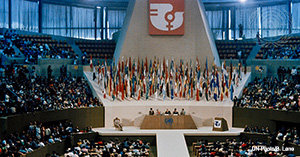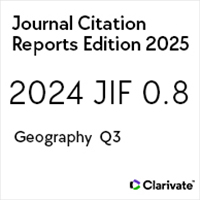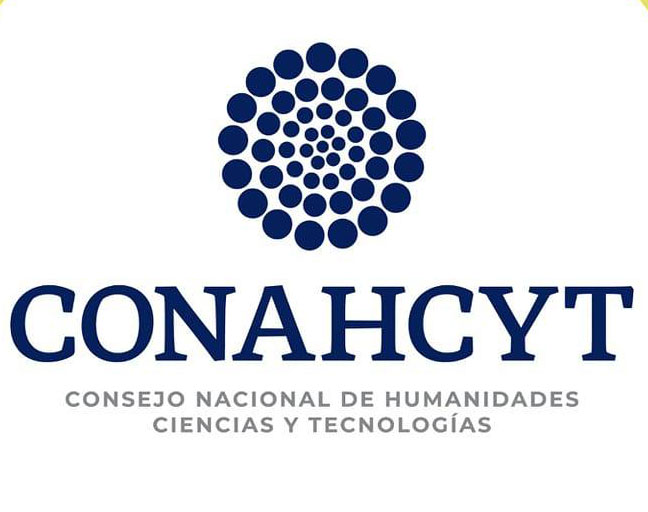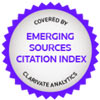Gender-responsive migration governance? The gendering of migration and border control on an international scale
¿Gobernanza migratoria con perspectiva de género? La generización del control migratorio y fronterizo en la escala internacional
https://doi.org/10.21670/ref.2515173
Keywords:
gender perspective, migration governance, gendering of migration and border controlAbstract
This paper aims to analyze the institutionalization of gender issues in the political field of migration and borders in order to account for the gendering of migration and border control at the international level. It reconstructs the production of an institutional framework, categories of intervention, and processes of subjectivation of refugee and migrant women. It shows that the gender governance and migration governance have been intertwined, giving rise to the novel form of control over populations in movement that consists of the metabolization and instrumentalization of the “gender perspective” in migration and border control policies and practices. The methodological framework is based on the documentary analysis of a set of reports, guides and memoirs produced in the context of events or institutions that played a leading role in the deployment of global governance, between the 1980s and 1990s.Resumen
El objetivo del artículo es analizar la institucionalización de cuestiones de género en el campo político de las migraciones y las fronteras, para dar cuenta de la generización del control migratorio y fronterizo en la escala internacional. Se reconstruye la producción de un entramado institucional, categorías de intervención y procesos de subjetivación de la mujer refugiada y migrante. Se muestra que de manera imbricada se han gestado la gobernanza del género y la gobernanza de las migraciones, dando lugar a una novedosa forma de control de las poblaciones en movimiento, que consiste en la metabolización e instrumentalización de la “perspectiva de género” en las políticas y prácticas de control migratorio y fronterizo. El encuadre metodológico está basado en el análisis documental de un conjunto de informes, guías y memorias producidos en el marco de eventos o instituciones protagonistas del despliegue de la gobernanza global, entre las décadas de 1980 y 1990.References
Alto Comisionado de las Naciones Unidas para los Refugiados (ACNUR). (1992, 21 de febrero). Declaración y compromiso del Primer Foro Regional “Enfoque de género en el trabajo con las mujeres refugiadas, repatriadas y desplazadas” (Forefem). https://www.refworld.org/es/ref/infortem/acnur/1992/es/131785
Andrijasevic, R. (2010). Migration, agency and citizenship in sex trafficking. Palgrave Macmillan. DOI: https://doi.org/10.1057/9780230299139
Ansaldi, W. & Giordano, V. (2012). América Latina, la construcción del orden. De las sociedades de masas a las sociedades en proceso de reestructuración. Ariel.
Aradau, C. (2008). Rethinking trafficking in women: politics out of security. Palgrave Macmillan. DOI: https://doi.org/10.1057/9780230584228
Aradau, C. (2010). Security that matters: critical infrastructure and objects of protection. Security Dialogue, 41(5), 491-514. https://doi.org/10.1177/0967010610382687 DOI: https://doi.org/10.1177/0967010610382687
Asamblea General. (1979, 17 de diciembre). 34/161. Mujeres refugiadas. En Resoluciones y decisiones aprobadas por la Asamblea General durante su trigésimo cuarto periodo de sesiones (pp. 211-212). Naciones Unidas. https://documents.un.org/doc/resolution/gen/nr0/384/90/pdf/nr038490.pdf
Asamblea General. (1980, 11 de diciembre). 35/135. Mujeres refugiadas y desplazadas. En Resoluciones y decisiones aprobadas por la Asamblea General durante su trigésimo quinto periodo de sesiones (p. 203). Naciones Unidas. https://docs.un.org/es/A/RES/35/136
Asamblea General. (1997). Informe del Consejo Económico y Social correspondiente a 1997 (Documentos oficiales, Quincuagésimo segundo periodo de sesiones, Suplemento No. 3 [A/52/3/Rev.1]). Naciones Unidas https://digitallibrary.un.org/record/271316/files/A_52_3_Rev-1-ES.pdf
Baines, E. K. (2016). Vulnerable bodies. Gender, the un and the global refugee crisis. Routledge.
Baines, E. K. (2000, agosto). The elusiveness of gender-related change in international organizations: refugee women, the United Nations High Commissioner for Refugees and the political economy of gender [Tesis doctoral, Dalhousie University]. https://dalspace.library.dal.ca/items/aecb9115-ee21-47d1-8e7b-6c6908764072
Basok, T., Piper, N. & Simmons, V. (2013). Disciplining female migration in Argentina: human rights in the time of migration management. En M. Geiger & A. Pécoud (Eds.), Disciplining the transnational mobility of people (International Political Economy Series, pp. 162-184). Palgrave Macmillan. DOI: https://doi.org/10.1057/9781137263070_9
Berthiaume, C. (1995). Do we really care? Refugees, 2(100). https://www.unhcr.org/publications/refugees-magazine-issue-100-refugee-women-do-we-really-care
Bigo, D. (2006). Protection. Security, territory and population. En J. Huysmans, A. Dobson & R. Prokhovink (Eds.), The politics of protection. Sites of insecurity and sites of insecurity and political agency (pp. 84-100). Routledge.
Binet, L. (2013). The MSF speaking out case studies. Salvadoran refugee camps in Honduras (1988). Médecins Sans Frontières. https://www.msf.org/sites/default/files/2019-04/MSF%20Speaking%20Out%20Honduras%201988.pdf
Brown, W. (2015). Undoing the demos. Neoliberalism’s stealth revolution. Zone Books. https://doi.org/10.2307/j.ctt17kk9p8 DOI: https://doi.org/10.2307/j.ctt17kk9p8
Butler, J. (2006). Deshacer el género. Paidós.
Butler, J. (2007). El género en disputa. El feminismo y la subversión de la identidad. Paidós. https://transreads.org/wp-content/uploads/2019/03/2019-03-18_5c8fe73d717ca_judith-butler-el-genero-en-disputa1.pdf
Castro, E. (2019). Diccionario Foucault. Temas, conceptos y autores. Siglo XXI editores.
Cavallero, L. & Gago, V. (2019). Una lectura feminista de la deuda. “Vivas, libres y desendeudadas nos queremos”. Fundación Rosa Luxemburgo. https://rosalux-ba.org/2019/05/09/una-lectura-feminista-de-la-deuda-pdf/
Clavijo, J. (En prensa). Wolf in sheep’s clothing: transformations of refuge through the protection-control relationship in the South American space. En S. Álvarez Velasco, N. de Genova, G. Dias & E. Domenech (Eds.), The borders of America. Migration, control, and resistance across Latin America and the Caribbean (pp. 249-276). Duke University Press.
Clavijo, J. & Sabogal, J. C. (2013, 16-20 de septiembre). Género y políticas de “migración forzada”: dinámicas de articulación reciente en el contexto regional [Ponencia]. Seminário internacional fazendo gênero 10. Desafios Atuais dos Feminismos, Florianópolis, Brasil. https://www.fg2013.wwc2017.eventos.dype.com.br/resources/anais/20/1373253567_ARQUIVO_PonenciaClavijo-Sabogal,FazendoGenero2013.pdf
Commission on Global Governance. (1992). Our global neighbourhood. https://www.gdrc.org/u-gov/global-neighbourhood/
Conferencia Internacional sobre Refugiados Centroamericanos. (1989, 30 de mayo). Declaración y plan de acción concertado en favor de los refugiados, repatriados y desplazados centroamericanos (Cirefca 89/13/Rev.1,). https://www.refworld.org/legal/resolution/iccar/1989/en/94122
Conferencia Internacional sobre Refugiados Centroamericanos. (1992, febrero). CIREFCA: Segunda reunión internacional del comité de seguimiento. San Salvador, 7 y 8 de abril 1992. Síntesis de los avances, estrategias y propuestas. https://www.refworld.org/es/ref/inforreg/cirefca/1992/es/127484
Conferencia Regional sobre Migraciones. (1996, 14 de marzo). I Conferencia regional sobre migración comunicado conjunto. https://www.iom.int/sites/g/files/tmzbdl486/files/2018-07/ES-1996-COMUNICADO-CONJUNTO-Puebla.pdf
Conferencia Regional sobre Migraciones. (2000). Mujeres, niñas y niños migrantes (Memoria del seminario realizado en El Salvador [24 y 25 de febrero de 2000] en el contexto del Proceso Puebla). Fundación Género y Sociedad. https://rcmvs.org/sites/default/files/tematicas/gen1_libro_-_mujeres_-_ninos_y_ninas_migrantes_2000.pdf
Conferencia Regional sobre Migraciones. (2007). Seminario mujer y migración. https://www.corteidh.or.cr/sitios/observaciones/11/Anexo9.pdf
Corazza Padovani, N. (2020). ¿Todas las mujeres acusadas de tráfico internacional de drogas son víctimas de trata de personas? Género, clase, raza y nacionalidad en los discursos sobre crimen organizado en Brasil. En D. Daich & C. Varela (Coords.), Los feminismos en la encrucijada del punitivismo. Editorial Biblos.
Daich, D. & Varela, C. (2020). Los feminismos en la encrucijada del punitivismo. Editorial Biblos.
De la Cruz, R. (2017). No asylum for the innocent: gendered representations of Salvadoran refugees in the 1980s. American Behavioral Scientist, 61(10), 1103-1118. https://doi.org/10.1177/0002764217732106 DOI: https://doi.org/10.1177/0002764217732106
Dias, G. M. (2017). Trata de personas, tráfico de migrantes y la gobernabilidad de la migración a través del crimen. Etnográfica, 21(3), 541-554. https://doi.org/10.4000/etnografica.5026 DOI: https://doi.org/10.4000/etnografica.5026
Domenech, E. (2013). “Las migraciones son como el agua”: hacia la instauración de políticas de “control con rostro humano”. La gobernabilidad migratoria en la Argentina. Polis. Revista Latinoamericana, (35). http://journals.openedition.org/polis/9280 DOI: https://doi.org/10.4067/S0718-65682013000200006
Domenech, E. (2017). Las políticas de migración en Sudamérica: elementos para el análisis crítico del control migratorio y fronterizo. Terceiro Milênio: Revista crítica de sociologia e política, 8(1), 19-48. https://www.revistaterceiromilenio.uenf.br/index.php/rtm/article/view/2
Domenech, E. (2023). Gobernabilidad migratoria. En C. Jiménez Zunino & V. Trpin (Coords.), Pensar las migraciones contemporáneas. Categorías críticas para su abordaje (pp. 193-203). Teseo Press. https://www.teseopress.com/migracionescontemporaneas/
Domenech, E. (En prensa). Fronteras en disputa: migración y crisis. Centro Maria Sibylla Merian de Estudios Latinoamericanos Avanzados (Calas) / Bielefeld University Press.
Dufraix Tapia, R. & Ramos Rodríguez, R. (2022). La “víctima ideal” del delito de trata de personas en el sistema penal chileno. Política criminal, 17(34), 795-818. http://politcrim.com/wp-content/uploads/2022/12/Vol17N34A14.pdf DOI: https://doi.org/10.4067/S0718-33992022000200795
Düvell, F. (2003, 30 de septiembre). The globalization of migration control. openDemocracy. https://www.opendemocracy.net/en/globalisation-of-migration-control/
Estupiñán Serrano, M. L. (2013). Acerca de la gobernanza y la gestión migratoria. Crítica del papel de la OIM en el gobierno de la migración internacional y regional (Red de posgrados, documentos de trabajo #33). Clacso. https://libreria.clacso.org/publicacion.php?p=829&c=22
Executive Committee of the High Commissioner’s Programme. (1985). Refugee women and international protection (36th session). United Nations High Commissioner for Refugees. https://www.unhcr.org/publications/refugee-women-and-international-protection
Executive Committee of the High Commissioner’s Programme. (1987, 3 de agosto). Note on international protection (submitted by the High Commissioner). un High Commissioner for Refugees. https://www.refworld.org/policy/unhcrnotes/unhcr/1987/en/91459
Executive Committee of the High Commissioner’s Programme. (1988, 10 de octubre). Refugee Women No. 54 (XXXIX). UNHCR. https://www.unhcr.org/publications/refugee-women#:~:text=54%20(XXXIX)%20%2D%201988,of%20protection%20and%20assistance%20programmes
Federici, S., Gago, V. & Cavallero, L. (Eds.). (2021). ¿Quién le debe a quién? Ensayos transnacionales de desobediencia financiera. Tinta Limón / Fundación Rosa Luxemburgo. https://tintalimon.com.ar/public/x2aajtw1zgx4u2c3gkvgowfl4se5/quien%20le%20debe%20a%20quien.pdf
Feminismo Autónomo Latinoamericano. (1997). Permanencia voluntaria en la Utopía. El Feminismo Autónomo en el VII Encuentro Feminista Latinoamericano y del Caribe, Chile 1996 (Colección Feminismos cómplices). La Correa Feminista.
Foucault, M. (1988). El sujeto y el poder. Revista Mexicana de Sociología, 50(3), 3-20. https://revistamexicanadesociologia.unam.mx/index.php/rms/article/view/61350 DOI: https://doi.org/10.2307/3540551
Geiger, M. & Pécoud, A. (2010). The politics of international migration management. En M. Geiger & A. Pécoud (Eds.), The politics of international migration management (pp. 1-20). Palgrave Macmillan. DOI: https://doi.org/10.1057/9780230294882_1
Gender Equality Unit. (2014). From 1975 to 2013: UNHCR’s gender equality chronology. unhcr. https://www.unhcr.org/media/1975-2013-unhcrs-gender-equality-chronology
General Assembly. (1981a). Addendum to the report of the United Nations High Commissioner for Refugees (A/36/12/Add.1). United Nations. https://digitallibrary.un.org/record/195669?v=pdf
General Assembly. (1981b). Report of the United Nations High Commissioner for Refugees. Supplement No. 12 (A/36/12). United Nations. https://www.unhcr.org/publications/report-united-nations-high-commissioner-refugees-12
General Assembly. (1982, 18 de agosto). Report of the United Nations High Commissioner for Refugees (A/37/12). https://www.unhcr.org/publications/report-united-nations-high-commissioner-refugees-26
General Assembly. (1983, 17 de agosto). Report of the United Nations High Commissioner for Refugees A/38/12. United Nations. https://www.unhcr.org/publications/report-united-nations-high-commissioner-refugees-3
General Assembly. (1984, 24 de agosto). Report of the United Nations High Commissioner for Refugees A/39/12. United Nations High Commissioner for Refugees. https://www.refworld.org/reference/annualreport/unhcr/1984/en/42092
General Assembly. (1986, octubre). Addendum to the report of the United Nations High Commissioner for Refugees (A/41/12/Add.1). United Nations. https://www.refworld.org/reference/annualreport/unhcr/1986/en/91468?prevPage=/node/91468
General Assembly. (1988). Addendum to the report of the United Nations High Commissioner for Refugees (A/42/12/Add.1). United Nations. https://digitallibrary.un.org/record/148526?v=pdf
Gil Araujo, S., Rosas, C. & Baiocchi, M. L. (2023). Deportabilidad, género y violencia legal: una revisión bibliográfica sobre deportaciones y políticas antitrata. Revista CIDOB d’afers internacionals, (133), 17-39. https://doi.org/10.24241/rcai.2023.133.1.17 DOI: https://doi.org/10.24241/rcai.2023.133.1.17
Global Commission on International Migration. (2005). Migration in an interconnected world: new directions for action (Report of the Global Commission on International Migration). https://www.iom.int/sites/g/files/tmzbdl486/files/jahia/webdav/site/myjahiasite/shared/shared/mainsite/policy_and_research/gcim/GCIM_Report_Complete.pdf
Golash-Boza, T. & Hondagneu-Sotelo, P. (2013). Latino immigrant men and the deportation crisis: a gendered racial removal program. Latino Studies, 11(3), 271-292. https://doi.org/10.1057/lst.2013.14 DOI: https://doi.org/10.1057/lst.2013.14
Gros Espiell, H., Picado, S. & Valladares Lanza, L. (1989). Principles and criteria for the protection of and assistance to Central American refugees, returnees and displaced persons in Latin America. International Conference on Central American Refugees. https://www.refworld.org/legal/otherinstr/iccar/1989/en/35524
Halley, J., Kotiswaran, P., Rebouché, R. & Shamir, H. (2018). Governance feminism. An introduction. University of Minnesota Press. DOI: https://doi.org/10.5749/j.ctt2121736
Hess, S. (2013). How gendered is the European migration regime? Ethnologia Europaea, 42(2), 51-68. https://www.researchgate.net/publication/346324725_HOW_GENDERED_IS_THE_EUROPEAN_MIGRATION_REGIME_A_Feminist_Analysis_of_the_Anti-Trafficking_Apparatus DOI: https://doi.org/10.16995/ee.1097
Hess, S., Hänsel, V. & Elle, J. (2022). Dangerous men and suffering women? Entanglements and articulations of gender in the European border regime. En V. Hänsel, M. Schmid-Semper, N. V. Schwarz (Eds.), Von Moria bis Hanau: Brutalisierung und Widerstand. Grenzregime IV, (pp. 360-384). Assoziation A.
Higer, A. (1999). International women’s activism and the 1994 Cairo Population Conference. En M. K. Mayer & E. Prügl (Eds.), Gender politics in global governance (pp. 122-141). Rowman & Littlefield.
Huysmans, J. (2006). Agency and the politics of protection: implications for security studies. En J. Huysmans, A. Dobson, R. Prokhovnik (Eds.), The politics of protection. Sites of insecurity and political agency (pp. 1-18). Routledge. DOI: https://doi.org/10.4324/9780203002780
Instituto Internacional de Investigaciones y Capacitación de las Naciones Unidas para la Promoción de la Mujer. (2006a). Remesas en Guatemala. https://trainingcentre.unwomen.org/instraw-library/2006-I-MIG-GTM-REM-SP.pdf
Instituto Internacional de Investigaciones y Capacitación de las Naciones Unidas para la Promoción de la Mujer. (2006b). Género y remesas [Sección]. Encuentros INSTRAW. https://trainingcentre.unwomen.org/instraw-library/2006-R-MIG-DOM-GEN.pdf
Instituto Internacional de Investigaciones y Capacitación de las Naciones Unidas para la Promoción de la Mujer & Organización Internacional para las Migraciones. (2006). Género y remesas. Migración colombiana del AMCO hacia España. https://trainingcentre.unwomen.org/instraw-library/2008-R-MIG-COL-SP.pdf
Joachim, J. M. (2007). Agenda setting, the un, and NGOs. Gender violence and reproductive rights. Georgetown University Press. DOI: https://doi.org/10.1353/book13055
Karatani, R. (2005). How history separated refugee and migrant regimes: in search of their institutional origins. International Journal of Refugee Law, 17(3), 517-541. https://doi.org/10.1093/ijrl/eei019 DOI: https://doi.org/10.1093/ijrl/eei019
Keck, M. E. & Sikkink, K. (1999). Transnational advocacy networks in international and regional politics. International Social Science Journal, (51), 89-101. https://doi.org/10.1111/issj.12187 DOI: https://doi.org/10.1111/1468-2451.00179
Kron, S. (2011). Gestión migratoria en Norte y Centroamérica: manifestaciones y contestaciones. Anuario de Estudios Centroamericanos, 37, 53-85. https://www.jstor.org/stable/41306433?seq=2
Kron, S. (2013). Central America: regional migration and border policies. En I. Ness (Ed.), The Encyclopedia of Global Human Migration (pp. 1-6). Wiley. https://doi.org/10.1002/9781444351071.wbeghm110 DOI: https://doi.org/10.1002/9781444351071.wbeghm110
Kulick, D. (2003). Sex in the new Europe. The criminalization of clients and Swedish fear of penetration. Anthropological Theory, 3(2), 199-218. https://doi.org/10.1177/1463499603003002005 DOI: https://doi.org/10.1177/1463499603003002005
Luibhéid, E. (2002). Entry denied. Controlling sexuality at the border. University of Minnesota Press.
Luibhéid, E. (2008a). Queer/migration. An unruly body of scholarship. GLQ, 14(2-3), 169-190. https://doi.org/10.1215/10642684-2007-029 DOI: https://doi.org/10.1215/10642684-2007-029
Luibhéid, E. (2008b). Sexuality, migration, and the shifting line between legal and illegal status. GLQ, 14(2-3), 289-315. https://doi.org/10.1215/10642684-2007-034 DOI: https://doi.org/10.1215/10642684-2007-034
Luibhéid, E. (2020). Treated neither with respect nor with dignity: contextualizing queer and trans migrant “illegalization,” detention, and deportation. En E. Luibhéid & K. R. Chávez (Eds.), Queer and trans migrations: dynamics of illegalization, detention, and deportation (pp. 19-40). University of Illinois Press. DOI: https://doi.org/10.5622/illinois/9780252043314.003.0002
Magliano, M. J. & Clavijo, J. (2011). La trata de personas en la agenda política sudamericana sobre migraciones: la securitización del debate migratorio. Análisis Político, 24(71), 149-163. https://revistas.unal.edu.co/index.php/anpol/article/view/44244
Magliano, M. J. & Clavijo, J. (2012). La trata de personas como ‘una forma abusiva de migración’: securitización del debate migratorio y criminalización del sujeto migrante. Aportes Andinos, (31). https://revistas.uasb.edu.ec/index.php/aa/article/view/3240
Magliano, M. J. & Clavijo, J. (2013). La OIM como trafficking solver para la región sudamericana: sentidos de las nuevas estrategias de control migratorio. En G. Karasik (Coord.), Migraciones internacionales. Reflexiones y estudios sobre la movilidad territorial contemporánea (pp. 129-148). Ciccus Ediciones.
Magliano, M. J. & Domenech, E. E. (2009). Género, política y migración en la agenda global. Transformaciones recientes en la región sudamericana. Migración y desarrollo, (12), 53-68. https://www.redalyc.org/articulo.oa?id=66012313003 DOI: https://doi.org/10.35533/myd.0712.mjm.eed
Magliano, M. J. & Romano, S. M. (2009, septiembre-diciembre). Migración, género y (sub)desarrollo en la agenda política internacional: una aproximación crítica desde la periferia sudamericana. Cuadernos del CENDES, 26(72), 101-129. https://www.redalyc.org/articulo.oa?id=40314494005
Maldonado Macedo, J. V. (2022). La criminalización selectiva del dispositivo antitrata en México. Experiencias de mujeres trans migrantes y trabajadoras sexuales [Dossier]. Papel Político, 27, 1-12. https://doi.org/10.11144/Javeriana.papo27.csda DOI: https://doi.org/10.11144/Javeriana.papo27.csda
Mazower, M. (2012). Governing the world: The history of an idea. 1818 to the present. Penguin Books.
Mezzadra, S. & Neilson, B. (2017). La frontera como método. Traficantes de sueños. https://traficantes.net/sites/default/files/pdfs/PC15_frontera_como_metodo.pdf
Naciones Unidas. (1989). Violence against women in the family. https://digitallibrary.un.org/record/82860?ln=es
Naciones Unidas. (1995). Informe de la conferencia internacional sobre la población y el desarrollo. El Cairo, 5 a 13 de septiembre de 1994. https://www.unfpa.org/sites/default/files/pub-pdf/icpd_spa.pdf
Nyers, P., De Génova, N. & Tazzioli, M. (2021). Protection [Sección del artículo]. En N. de Genova & M. Tazzioli (Coords. & Eds.), Aradau, C., Bhandar, B., Bojadzijev, M., Cisneros, J. D., De Genova, N., Eckert, J., Fontanari, E., Golash-Boza, T., Huysmans, J., Khosravi, S., Lecadet, C., Macías Rojas, P., Mazzara, F., McNevin, A., Nyers, P., Scheel, S., Sharma, N., Stierl, M., Squire, V., Tazzioli, M., Van Baar, H. & Walters, W. (Authors). Minor keywords of political theory: Migration as a critical standpoint. Environment and Planning C: Politics and Space, 40(4), 781-875. https://doi.org/10.1177/2399654420988563 DOI: https://doi.org/10.1177/2399654420988563
Office of the United Nations High Commissioner for Refugees. (1991). Guidelines on the protection of refugee women. https://www.unhcr.org/media/guidelines-protection-refugee-women
O’Hara, F. (2024). Refugee camps as spaces of the global Cold War: Cold War activism and humanitarian action within refugee camps in Honduras during the 1980s. Cold War History. https://doi.org/10.1080/14682745.2024.2306394 DOI: https://doi.org/10.1080/14682745.2024.2306394
Organización Internacional para las Migraciones (OIM). (1995, 7 de noviembre). Staff and programme policy on gender issues. https://www.un.org/womenwatch/ianwge/repository/IOM_Policy.pdf
Organización Internacional para las Migraciones (OIM). (1999). The Bangkok declaration on irregular migration (International symposium on migration “Towards regional cooperation on irregular/undocumented migration”, 21-23 April 1999). https://www.iom.int/sites/g/files/tmzbdl486/files/jahia/webdav/site/myjahiasite/shared/shared/mainsite/policy_and_research/rcp/APC/BANGKOK_DECLARATION.pdf
Organización Internacional para las Migraciones (OIM). (2002, 13 de noviembre). Derechos de los migrantes. Políticas y actividades de la oim (Octogésima cuarta reunión). https://governingbodies.iom.int/jahia/webdav/shared/shared/mainsite/about_iom/es/council/84/Mcinf259.pdf
Piscitelli, A. (2015, 27-30 mayo). Régimenes de trata em momentos de alteracoes geopolíticas: reflexiones a partir de Brasil [Conferencia]. LASA 2015, Precariedades, exclusiones, emergencias, XXXIII Congreso Internacional de la Latin American Studies Association, San Juan, Puerto Rico. https://www.academia.edu/12819296/REG%C3%8DMENES_DE_TRATA_EM_MOMENTOS_DE_ALTERA%C3%87%C3%95ES_GEOPOL%C3%8DTICAS_REFLEXIONES_A_PARTIR_DE_BRASIL
Piscitelli, A. & Lowenkron, L. (2015). Categorias em movimento: a gestão de vítimas do tráfico de pessoas na Espanha e no Brasil. Ciência e Cultura, 67(2), 35-39. https://doi.org/10.21800/2317-66602015000200012 DOI: https://doi.org/10.21800/2317-66602015000200012
Reuniones Regionales. (1999, 28 de enero). Declaración conjunta de la Red no gubernamental para las migraciones ante la IV Conferencia Regional sobre Migración. https://www.refworld.org/es/ref/infortem/rreg/1999/es/130271
Rojas, R. (2021). El árbol de las revoluciones: ideas y poder en América Latina. Turner.
Rosas, C. & Gil Araujo, S. (2022). Régimen generizado de control migratorio y fronterizo. La producción de expulsabilidad en Argentina. Estudios Fronterizos, 23, Artículo e104. https://doi.org/10.21670/ref.2220104 DOI: https://doi.org/10.21670/ref.2220104
Rostica, J. (2015). Racismo y genocidio en Guatemala: una mirada de larga duración (1851-1990). Revista de Estudios sobre Genocidio, 7(10), 57-80. https://ri.conicet.gov.ar/handle/11336/70409
Rostica, J. C. (2017). El anticomunismo y el fracaso de la “integración” del indio. Hacia la coyuntura crítica del genocidio en Guatemala (1954-1978). Theomai, (36), 24-42. https://ri.conicet.gov.ar/handle/11336/75335
Rostica, J. (2023). Racismo y genocidio en Guatemala. Una mirada de larga duración. Consejo Latinoamericano de Ciencias Sociales. https://libreria.clacso.org/publicacion.php?p=3052&c=37
Ruiz, M. C. (2017). Sexualidad, migraciones y fronteras en contextos de integración sur-sur. Sexualidad, Salud y Sociedad, (26), 18-37. https://www.e-publicacoes.uerj.br/SexualidadSaludySociedad/article/view/21232 DOI: https://doi.org/10.1590/1984-6487.sess.2017.26.02.a
Ruiz M., M. C. (2022). Transacciones eróticas en la frontera sur de Ecuador. Flacso Ecuador. https://repositorio.flacsoandes.edu.ec/handle/10469/20265 DOI: https://doi.org/10.46546/2022-34atrio
Ruiz Muriel, M. C. & Álvarez Velasco, S. (2019). Excluir para proteger: la “guerra” contra la trata y el tráfico de migrantes y las nuevas lógicas de control migratorio en Ecuador. Estudios Sociológicos, 37(111), 689-725. https://doi.org/10.24201/es.2019v37n111.1686 DOI: https://doi.org/10.24201/es.2019v37n111.1686
Saleh, F. (2020a). Queer/humanitarian visibility: the emergence of the figure of the suffering Syrian gay refugee. Middle East Critique, 29(1), 47-67. https://doi.org/10.1080/19436149.2020.1704501 DOI: https://doi.org/10.1080/19436149.2020.1704501
Saleh, F. (2020b). Resettlement as securitization: war, humanitarianism, and the production of Syrian LGBT refugees. En E. Luibhéid & K. R. Chávez (Eds.), Queer and trans migrations. Dynamics of illegalization, detention, and deportation (pp. 74-89). University of Illinois Press. DOI: https://doi.org/10.5622/illinois/9780252043314.003.0006
Santi, S. (2020). ¿Qué es la “migración ordenada”? Hacia el multilateralismo asimétrico como motor de las políticas de control migratorio global. Colombia Internacional, (104), 3-32. https://doi.org/10.7440/colombiaint104.2020.01 DOI: https://doi.org/10.7440/colombiaint104.2020.01
Schrover, M. & Moloney, D. M. (2013). Gender, migration and categorisation: making distinctions between migrants in Western countries, 1945-2010 (Imiscoe Research). Amsterdam University Press. https://www.imiscoe.org/docman-books/255-schrover-moloney-2013
Schrover, M., Van der Leun, J., Lucassen, L. & Quispel, C. (Eds.). (2008). Illegal migration and gender in a global and historical perspective (Imiscoe Research). Amsterdam University Press. https://library.oapen.org/bitstream/id/a0b958eb-8288-42c9-b7fc-ae45c8d640ed/340072.pdf
Schrover, M. & Yeo, E. J. (Eds.). (2010). Gender, migration, and the public sphere, 1850-2005. Routledge. DOI: https://doi.org/10.4324/9780203866559
Sciortino, G. (2004). Immigration in a Mediterranean welfare state: the Italian experience in comparative perspective. Journal of Comparative Policy Analysis: Research and Practice, 6(2), 111-129. https://doi.org/10.1080/1387698042000273442 DOI: https://doi.org/10.1080/1387698042000273442
Spencer-Nimmons, N. (1994, diciembre). Canada’s response to the issue of refugee women: the women at risk program. Refuge, 14(7), 13-18. https://doi.org/10.25071/1920-7336.21843 DOI: https://doi.org/10.25071/1920-7336.21843
Ticktin, M. (2008). Sexual violence as the language of border control: where French feminist and anti-immigrant rhetoric meet. Journal of Women in Culture and Society, 33(4), 863-889. https://academicworks.cuny.edu/gc_pubs/840/ DOI: https://doi.org/10.1086/528851
Ticktin, M. (2011a). Casualties of care. Immigration and the politics of humanitarianism in France. University of California Press. DOI: https://doi.org/10.1525/9780520950535
Ticktin, M. (2011b). The gendered human of humanitarianism: medicalising and politicising sexual violence. Gender & History, 23(2), 250-265. https://doi.org/10.1111/j.1468-0424.2011.01637.x DOI: https://doi.org/10.1111/j.1468-0424.2011.01637.x
Torres-Rivas, E. (Ed.). (1994). Historia general de Centroamérica. Historia inmediata (t. vi). Flacso.
Torres-Rivas, E. (2006). Centroamérica. Revoluciones sin cambio revolucionario. En W. Ansaldi (Coord.), Calidoscopio latinoamericano. Imágenes históricas para un debate vigente (2a. ed., pp. 281-312). Ariel.
Trabalón, C. (2021). Racialización del control y nuevas migraciones: procesos de ilegalización durante la última década en la Argentina. Periplos. Revista de Investigación sobre Migraciones, 5(1), 207-234. https://periodicos.unb.br/index.php/obmigra_periplos/article/view/34727
Trabalón, C. (2024). La migración “extrarregional” como categoría racial. Gobernanza migratoria y “tránsitos sur-norte” en Sudamérica y Mesoamérica. Si Somos Americanos, 24. https://doi.org/10.61303/07190948.v24i.1151 DOI: https://doi.org/10.61303/07190948.v24i.1151
United Nations. (1995). Beijing declaration and platform for action. Beijing+5 political declaration and outcome. https://www.unwomen.org/en/digital-library/publications/2015/01/beijing-declaration
United Nations Entity for Gender Equality and the Empowerment of Women. (2016). The legacy of Instraw in promoting the rights of women: A historical record of the Institute between 1976 and 2010. https://trainingcentre.unwomen.org/RESOURCES_LIBRARY/Resources_Centre/Instraw%20Legacy%20English%20pdf.pdf
United Nations High Commissioner for Refugees. (1980, 14-30 de julio). The situation of the women refugees the world over [Conferencia]. World conference of the United Nations. Decade for Women: Equality, Development and Peace. Copenhagen, Denmark. https://digitallibrary.un.org/record/13518?ln=es&v=pdf
United Nations International Research and Training Institute for the Advancement of Women (Instraw). (2006). Gender, remittances and development. The case of women migrants from Vicente Noble, Dominican Republic. https://digitallibrary.un.org/record/607707?ln=es&v=pdf
Walters, W. (2004). “Some critical notes on ‘governance’.” Studies in political economy, 73(1), 27-46. https://doi.org/10.1080/19187033.2004.11675150 DOI: https://doi.org/10.1080/19187033.2004.11675150
Wiltberger, J. & Baltazar Flores, C. (Coeds.). (2022). Refuge and return: stories of a resettled community in El Salvador. California State University Northridge. https://scalar.usc.edu/works/el-salvador-oral-history-project/index
Women’s Commission for Refugee Women and Children. (2002, mayo). UNHCR policy on refugee women and guidelines on their protection: an assessment of ten years of implementation. Women’s Refugee Commission. https://www.womensrefugeecommission.org/research-resources/unhcr-policy-on-refugee-women-and-guidelines-on-their-protection-an-assessment-of-ten-years-of-implementation/
Xiang, B. (2013). Multi-scalar ethnography: an approach for critical engagement with migration and social change. Ethnography, 14(3), 282-299. https://doi.org/10.1177/1466138113491669 DOI: https://doi.org/10.1177/1466138113491669
































